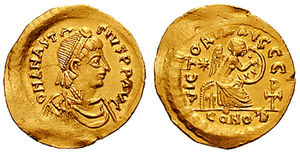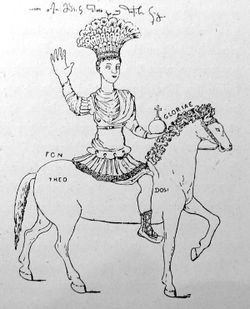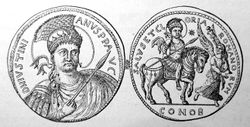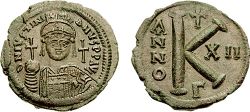عاج بربريني

عاج بربريني Barberini ivory هو صفيحة عاجية بيزنطية ذات صفحتين تعود إلى القدم المتأخر، وتوجد حالياً في اللوڤر بپاريس. وتمثل الامبراطور منتصراً. وتُؤرَّخ عموماً بأنها صُنعت في النصف الأول من القرن السادس وتُنسب إلى ورشة امبراطورية في القسطنطينية، بينما الامبراطور غالباً هو جستنيان، أو ربما أنستاسيوس الأول أو زينون. وهي وثيقة تاريخية هامة لأنها ترتبط بالملكة برونهيلدا من أستراسيا. وعلى ظهرها توجد قائمة أسماء ملوك الفرنجة، وكلهم أقارب برونهيلدا، مما يدل على أهمية دور الملكات في العائلات الملكية للفرنجة. أمرت برونهيلدا بنقش القائمة وأهدتها للكنيسة كنذر.
وبالرغم من أنها ليست لوح مزدوج قنصلي, it shares many features of their decorative schemes. The emperor is accompanied in the main panel by a conquered barbarian in trousers at left, a crouching allegorical figure, probably representing territory conquered or reconquered, who holds his foot in thanks or submission, and an angel or victory, crowning the emperor with the traditional palm of victory (which is now lost). Although the barbarian is partly hidden by the emperor's huge spear, this does not pierce him, and he seems more astonished and over-awed than combative. Above, Christ, with a fashionable curled hair-style, is flanked by two more angels in the style of pagan victory figures; he reigns above, while the emperor represents him below on earth. In the bottom panel barbarians from West (left, in trousers) and East (right, with ivory tusks, a tiger and a small elephant) bring tribute, which includes wild animals. The figure in the left panel, representing a soldier, carries a statuette of Victory; مقابله على اليمين مفقود.
رسم الأيقونات
اللوحة الوسطى
اللوحات الجانبية
اللوحة السفلى

التعرف على الامبراطور
The question of the identity of the emperor represented on the central panel is the central problem to have occupied commentators on the Barberini ivory – its first modern owner, Peiresc, recognised him without hesitation as Heraclius and identified the officer offering the statuette of Victory as his son Constantine III. Later identifications of the central figure have also included Constantine I, Constantius II, Zeno and above all Anastasius I or Justinian.[1] The identification is complicated by the fact that the emperor shown is not necessarily the reigning emperor at the date when the ivory was produced. Thus the dating of the ivory is undeniably a useful indication in identifying the emperor but it is not conclusive in that regard.
أنستاسيوس

From a stylistic point of view, the high-relief sculpture of the central panel is comparable to two other ivory panels dating to the start of the 6th century, each representing an empress – one is at the Bargello in Florence (يسار), the other at the Kunsthistorisches Museum in Vienna.[2] They show the empress Ariadne (?-518), wife of the emperor زينون (430-491) and then of Anastasius I (491-518). This parallel could suggest identifying the emperor on عاج بربريني with Anastasius.
جستنيان
The lower-relief style of the secondary panels, and notably the purely graphic and unplastic rendering of clothing, accommodates a later dating of the work to around the middle of the 6th century. The work's combination of high-quality reliefs evokes another famous work of ivory sculpture of this era, the Throne of Maximian at Ravenna, datable to 545-556, and another product of a top-quality workshop, perhaps even the same one, in either Constantinople or Alexandria – this would make the triumphant emperor Justinian.[3]



الهامش
- ^ For the bibliography for these various identifications, see Cutler, op. cit. 335-336.
- ^ Diptych of Ariadne Archived سبتمبر 30, 2007 at the Wayback Machine at the Kunsthistorisches Museum in Vienna.
- ^ Kitzinger, 94-97
المراجع
- Antony Cutler, "Barberiniana. Notes on the Making, Content, and Provenance of Louvre OA. 9063", Tesserae : Festschrift für Josef Engemann, Jahrbuch für Antike und Christentum, Ergänzungsband 18, 1993, p. 329-339;
- (بالفرنسية) Danièle Gaborit-Chopin, in Byzance, l'art byzantin dans les collections publiques françaises (catalogue of an exhibition at the Louvre, 3 November 1992 – 1 February 1993), Paris, 1993, numéro 20, p. 63-65;
- (بالفرنسية) A. Héron de Villefosse, « L'Ivoire de Peiresc », Mémoires de la Société nationale des Antiquaires de France, 75, 1915-1918, p. 267-295;
- Kitzinger, Ernst, Byzantine art in the making: main lines of stylistic development in Mediterranean art, 3rd-7th century, 1977, Faber & Faber, ISBN 0571111548 (US: Cambridge UP, 1977)
- (بالفرنسية) Jean-Pierre Sodini, "Images sculptées et propagande impériale du IVe au VIe siècle : recherches récentes sur les colonnes honorifiques et les reliefs politiques à Byzance", in A. Guillou et J. Durand, Byzance et les images, La Documentation française, Paris, 1994, p. 43-94;
- (بالألمانية) Richard Delbrück, Die Consulardiptychen und verwandte Denkmäler, Berlin, 1929, numéro 48;
- (بالألمانية) Wolfgang Fritz Volbach, Elfenbeinarbeiten der Spätantike und des Frühen Mittelalters, Mainz, 1952 2, numéro 48, p. 36-37.
للاستزادة
- Weitzmann, Kurt, ed., Age of spirituality : late antique and early Christian art, third to seventh century, no. 28, 1979, Metropolitan Museum of Art, New York, ISBN 9780870991790; full text available online from The Metropolitan Museum of Art Libraries
وصلات خارجية
- Catalogue entry on the Louvre's Atlas database (بالفرنسية)




